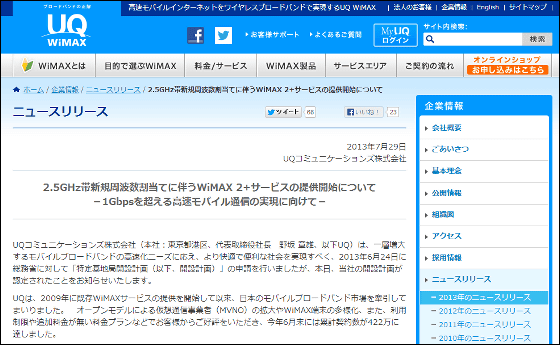"WiMAX 2 +" starts service from the end of October 2013, the fastest downlink goes beyond 1 Gbps in 2017

UQ Communications has applied for the purpose of speeding up "specific base station opening plan" has been certified, ultra high speed mobile broadband service "WiMAX 2 +It is possible to offer it.
Start of offering WiMAX 2+ service accompanying new frequency allocation in the 2.5 GHz band | UQ WiMAX - High speed mobile Internet with wireless broadband
http://www.uqwimax.jp/annai/news_release/201307291.html

WiMAX 2 has been considered by UQ Communications for some timeHigh-speed communication service exceeding WiMAX, Which provides super high speed communication by using the frequency of 30 MHz currently used and 20 MHz newly allocated, totaling 50 MHz.
Features are the following five.

◆ 1: Ultra high speed mobile broadband service
In the future, it achieves speed exceeding 1 Gbps downstream
◆ 2: Further expansion of frequency utilization efficiency
Improvement of network capacity
◆ 3: Building an ecosystem by ensuring compatibility with the TD-LTE system
Procurement of terminals and equipment at lower cost
◆ 4: Expansion of high-speed mobility functions
High speed and large capacity communication at 350 km / h
◆ 5: Maintain seamless service with WiMAX (802.16e)
Continue to use the current WiMAX terminal
First,Start service at 110 Mbps from the end of October 2013.
The mechanism that can speed up is as follows

Furthermore, by introducing various kinds of high-speed technology such as carrier aggregation which increases speed by bundling a plurality of frequency channels and 256 QAM modulation system, 8 × 8 MIMO which improves communication speed by spatial multiplexing technology using plural antennas,In 2017 we plan to make ultra high-speed service exceeding 1 Gbps downstreamIt is said that.

The area is planned to be expanded to overlap with existing WiMAX service area, and seamless switching will be realized by preparing terminals that can use both existing WiMAX and WiMAX 2 +.

Related Posts:
in Smartphone, Posted by logc_nt







